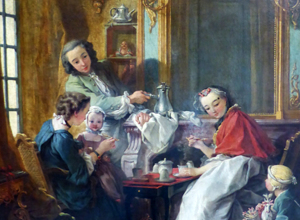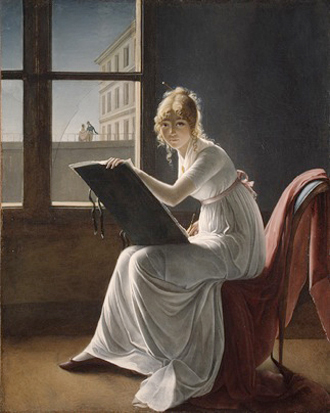
Anne Lafont reexamines the aftermath of the French Revolution, where the imperatives of equality and liberty held sway, though not that of the “fraternity” that had also been inscribed within the program—at least not when it came to women. Even though the author is well aware that the category of the “modern” had long ago been undermined, she is working to advance, through affirmative action, the work of writers and artists—including, but not limited to, Élizabeth Vigée-Lebrun, whose public involvements earned her a reputation as a monster. That reputation was, in her case, to lend her wings, already tested by men, that would come to inspire respect for her life, her work, her “matronage,” and her Conseils pour la peinture de portrait (Advice for portrait painting).
In examining the history of creative women, most of whom are still neglected, Lafont delineates circles, networks, and forms of solidarity, but also some of the forms of self-representation they created in order to win recognition for themselves on an arts scene in which it was still mainly men who stood out.
Laurence Bertrand Dorléac
Liberty, Equality, Sorority:
The Art of 1800
Anne Lafont
This seminar devoted to the passion for equality offers the occasion to return to a period of history when the desire for equality was remarkably defined and proclaimed. That period is the French Revolution, during the course of which the Ancien Régime was overthrown in the hope of putting an end to social and constitutional inequalities and of founding a new political system whose motive principles would be, as a matter of fact, liberty, equality, and fraternity. Now, it is through this last aspect that the Revolution, as ambitious as it was in what was said and what it enacted into law, singularly sinned—doing so to the point that it put into place a series of constitutions that limited and controlled the rights of women, those fraternal sisters, often going against the momentum built up in the Enlightenment.[ref]Fraisse, 1989.[/ref]
I will broach the question of the passion for equality in postrevolutionary artistic society therefore from the standpoint of Male/Female relationships. For, that makes sense for the history of art from at least two perspectives: women artists seized upon the few liberal measures adopted during the early years of the Revolution to take up professional careers in a broader way than before; and, in parallel with that development, the Revolution corresponded in time—somewhat roughly—to the swan song of the motto that had been, in both theory and practice, the driving force behind the Fine Arts in Renaissance, namely, Horace’s line Ut Pictura Poesis, in other words: “As is painting, so is poetry.” In its gloss and in its many manifestations, this aphorism gave rise—here, too, we are offering a succinct summary—to a shared rule for the making and the reception of academic painting as regards its capacity to imitate and to represent the heroic deeds of humanity as sung by poetry. Through a reversal—which was underscored by Rensselaer W. Lee as early as 1940[ref]Lee, (1940) 1991.[/ref] —painting had to, equal to poetry—by which we are to understand literature—demonstrate its capacity to magnify what was liable to magnification in the history of men.
As I do not believe that this might be some sort of accidental chronological coincidence, it seems to me to be of some interest to deepen these “sororities,” that is to say, this complicity, soon to be doomed to separation, between the Fine Arts and literature and, simultaneously, to reexamine the place of women in that more and more exclusively masculine society through the study of a still neglected group, women authors and women artists around the year 1800. And from that standpoint, one might consider the paradigmatic character of this group within the history of modernity in the arts, whose narrative has been, over the past 150 years, that of the margins taking over the center. Now, the women of 1800, both artists and authors, participated in this movement from the margins toward the heart of French intellectual and artistic life, if one considers the most famous among them, after the examples of Germaine de Staël and Elisabeth Vigée-Lebrun.[ref]This question of women and discourses on art in the eighteenth and nineteenth centuries are the topic of a collective work that will appear in May 2012, edited by Fend, Hyde, and Lafont.[/ref].
Nonetheless, this conviction and this stimulating question are necessarily shaken by the rereading of modernity we owe to the works of Bruno Latour,[ref]Latour, 1991.[/ref] who demonstrates the progressivist illusion behind this concept, all the more so as the agency of that concept remains strikingly strong in the field of historiography. Also, for me it seems impossible to avoid it totally and thus preferable to make a critical use of it, that is to say, to invoke it while remaining aware of what determines it within a particular context. This is all the more the case since accepting the modernity of the category of women artists and women authors allows one, in fact, to shift this concept and make it cover a more fecund and productive field than the now-discredited pre-Latourian fiction had done. While this approach is a bit paradoxical, it boils down to choosing “affirmative action” over denial. It does indeed seem more useful to develop a concept that has been identified as weak, but still of use, than to exclude therefrom a group, women, under the pretext that that concept is unsatisfactory.
Consequently, women will take their place in this narrative of a critical modernity, which I propose to define through the creation of a network of relations composed of the following qualities: self-referentiality, engagement, and matronage, or the need to acquire a following.
Sisters at Work

1. Nisa Villers, Self-Portrait, 1796, New York, Metropolitan Museum of Art. Oil on canvas, 161.3 x 128.6 cm.
Among the pioneering texts that have taken on the issues of creativity and gender through the presentation of female figures, one must include: the character of Nathalie in Madame de Genlis’s La femme auteur (1806); that of the improviser (who was at once musician, poet, and actress) Corinne in the eponymous novel written by Germaine de Staël, which appeared a year later, in 1807; and, finally, the woman painter Constance de Salm, who was the author of a single novel, 24 heures d’une femme sensible, which appeared in 1824. But one would also have to include the numerous portraits and self-portraits of women artists in their studios (Elisabeth Vigée-Lebrun, Adélaïde Labille-Guiard, Nisa Villers, and Marguerite Gérard, to mention just the most well-known ones; see illustration 1, Villers).
The still experimental character of the theorization of women in the process of creation during this preinstitutional era forbids one from cutting oneself off from an overall reflection on the topic by focusing exclusively on the figure of the woman painter. If one wishes to bring out a few ideas of decisive importance for the definition of the woman artist, one must in effect borrow from the entire set of fictional figures (themselves more or less disguised doubles of the female authors) and real personalities seen from the perspective of their place as artists and as women in society. What emerges from the reflections brought forth by these various heroines is that, while it was understood that a woman might engage in the activities of writing, painting, music, or drawing as some sort pastime or as an incidental activity, things proceeded quite differently when her pretensions led her, on the one hand, to bring those activities to the public’s attention and, on the other hand, to covet, through them, a form of celebrity. According to de Genlis, de Salm, and de Staël, these two ambitions necessarily lead to a strange amalgamation of a fall in status and degeneration. In the case of Corinne, this dressing up as a man, via her public claims to literary and musical creativity, mixed with binationality (since she is Anglo-Italian) appear in the novel as proofs of her degenerate character and will even lead her to her death.
Publication and Celebrity, as demands of the creative woman of 1800 and initial expressions of an explicit feminism that echoed the texts and positions of Olympe de Gouges, were at the time conveyed especially in the field of fiction. And even though the women authors often made sure that their heroines would be accompanied by sisters who served as a farsighted and benevolent double (Dorothée for Nathalie) or else as an opposite double rooted in the identity codes of her time (Lucile for Corinne), a luckless fate always caught up with the daring woman.
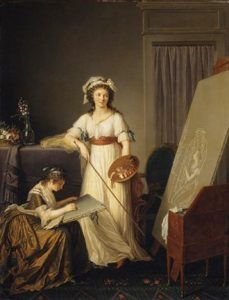
2. Marie-Victoire Lemoine, Atelier of a Painter (Elisabeth Vigée-Lebrun and Marie-Victoire Lemoine), 1796, New York, Metropolitan Museum of Art. Oil on canvas, 116.5 x 88.9 cm.
Vigée-Lebrun, who was described as a hermaphrodite and a monster by critics, eventually had to pay for her outsized celebrity. One of the first women to have been received at the French Royal Academy of Painting and Sculpture along with Labille-Guiard, in 1783, she took on, within her lifetime, the burden of seeing to her own posterity and opted for a well-tested strategy. Indeed, it was at age eighty, in the 1830s, that Vigée-Lebrun began to draft her memoirs, which appeared in 1867 under the title Souvenirs. There, she related her life as an emigrée traveling through Europe since the beginning of the French Revolution, but she took care especially to appropriate and to adapt to her own life the tropes of that foundational work of arts literature: Vasari’s Lives (1550). It mattered little to her to invent a specific mythography; for her, it was a question, rather, of assuring herself an eternal fortune by the hackneyed means that had already succeeded in the legends—as it happens, masculine ones—of the Fine Arts, along the lines of Titian and Leonardo.[ref]Sheriff, 1997, pp. 180-194. Sheriff, in Fend, Hyde, and Lafont, ed., 2012.[/ref]. Cunning in politics, a field she had closely frequented, Vigée-Lebrun accompanied this writing strategy with its inevitable counterpart and began the task of transmission not through the upkeep of a studio, which she could not establish during her life of wandering across Europe, but through the drafting of an opuscule, Conseils pour la peinture de portrait (Advice for portrait painting), which she intended for young women desirous of becoming, in her image, portrait painters (illustration 2, Lemoyne).
Matronage
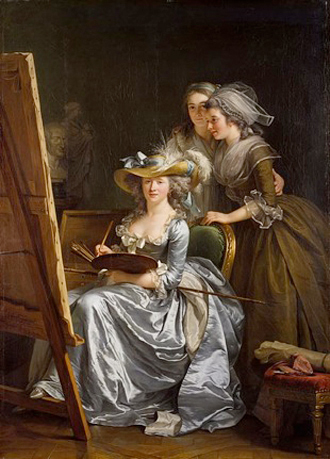
3. Adélaïde Labille-Guiard, Self-Portrait with Two Pupils (Marie-Gabrielle Capet and Melle Carreaux de Rosemond), 1785, Paris, Louvre Museum. Oil on canvas. 211 X 151 cm.
Indeed, what artist has not benefitted from a postmortem aura through his students, his studio, his followers, a generation actively following in the tradition of a master or, in this instance, as Roszika Parker and Griselda Pollock would say, of a mistress?[ref]Parker et Pollock, 1981.[/ref] In the 1780s, Vigée-Lebrun’s rival, Labille-Guiard, had a front-row seat so that she might observe studio dynamics at close range, since she had become initiated into the art of the miniature at the sides of François-Elie Vincent, the father of the history painter François-André Vincent, who in turn taught painting to this young woman before marrying her in 1799. Now, in the 1780s, Vincent fils was the close competitor of Jacques-Louis David. Pierre-Nolasque Bergeret, Jean-Joseph Ansiaux, Charles Paul Landon, Charles Meynier, and Charles Thévenin, among numerous others, were his students, and they became painters of the first rank upon the completion of their training in his studio, a studio that was, nevertheless, less reputed than David’s. Also, if one is to believe her 1785 self-portrait with two students (illustration 3), Labille-Guiard engaged in a career as a teacher and positioned herself at the head of a clan of women artists—two decisions that were to earn her both a circle of influence and a lasting aura, like that of any headmaster or headmistress of a school.[ref]Auricchio, 2009, pp. 104-109.[/ref]. It seems, moreover, that creative women quickly understood the need to demonstrate a sort of female solidarity in those times that were not very promising for their careers, and all the more so as they were on the way to becoming the competitors of men on the fields of glory having to do with inventiveness that had been, until that time, men’s undisputed prerogative. Correspondence as well as portraits testify to the intense mutual bonds women artists and women authors formed. De Staël rubbed shoulders with Vigée-Lebrun, Juliette Récamier, de Salm, Gérard, whereas Félicité de Genlis, who was close to the Orléans family and engaged in the humanistic and artistic education of princes, frequented Labille-Guiard but also de Gouges.[ref]See also Sofio, 2007.[/ref]
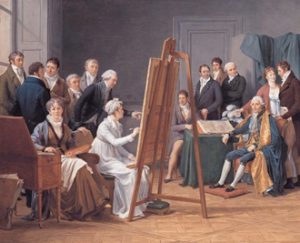
4. Marie-Gabrielle Capet, The Atelier of Madame Vincent, 1808, Neue Pinakothek, Munich. Oil on canvas, 69 X 83.5 cm.
Evidence of the innumerable mutual bonds they maintained despite some just as striking feelings of enmity and jealousy—I am thinking, in particular, of Vigée-Lebrun’s and de Genlis’s opposite career choices concerning the Academy and of the divergent political opinions of de Staël and de Genlis—abounds as concerns the establishment of shared professional and artistic experiences on the part of women within circa 1800 French society.
Among the followers of Labille-Guiard, one of them, Marie-Gabrielle Capet, appropriated for herself in a remarkable way this clannish strategy and even worked on her performative identity on three different levels, as may interestingly be observed in a painting that served as a manifesto (illustration 4, Capet).
One notes, first of all, the identity of the woman artist, whose legitimacy here is based on family ties (one sees in the picture the Vien couple, both of whom were painters; the same configuration for the Vincents, who are also represented, and about whom it is also known that they had virtually adopted Marie-Gabrielle Capet, author of the picture in which she also appears). This legitimation of the creative activity of women by their subordination to the chieftainship of their husband (Madame Vien and Madame Vincent were among the rare women painters to have entered into the French Royal Academy of Painting and Sculpture under the Ancien Régime) reveals a quite relative emancipation of these women as artists. Next, the picture affirms a political-aesthetic identity for these personalities and their direct connection with the stylistic movement to renovate history painting that had been inaugurated by the “regenerator” of the French School, Joseph-Marie Vien, portrayed here as a senator. Now, Vien was also the master of David who, for his part, and unlike the royalist Vincent, embraced the ideals of the Revolution and actively participated in its institutions, including those under the Terror. Finally, Capet forces one to reflect on gender in the circa 1800 arts community via the presence of three women artists found in his imaginary studio that differs conspicuously from the representation of the exclusively male Davidian clan (which can be seen gathered together in the society salon of Isabey, as painted by Boilly in 1798; illustration 5, Boilly).
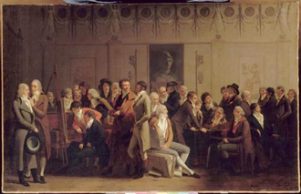
5. Louis-Léopold Boilly, Reunion of Artists in the Studio of Isabey, 1798, Paris, Louvre Museum. Oil on canvas, 71 X 111 cm.
In conclusion, I would say that, from a communitarian standpoint, the question of women artists comes into existence with the French Revolution, which called for a definition of the citizen-subject and his unrepresented others (in particular, women); that this question involves a reflection on the diversification of (familial, clannish, or individual) professional strategies and on the ways in which those strategies are represented, in a mode that is not unrelated to the method of autosuggestion [la méthode Coué], as is testified to by the existence of numerous painted portraits and self-portraits that show one painting. Finally, the status of circa 1800 women artists is indissociable from that of contemporary women authors, from Elisabeth Vigée-Lebun to Félicité de Genlis, for a similar and specific relation to creativity and celebrity takes shape at that time. In this context, the passion for equality is played out not only on the level of one’s professional and legal status but also as regards women artists’ legitimate claims to glory, in that such glory expresses a form of public recognition.
Bibliographie
AURICCHIO, Laura. Adélaïde Labille-Guiard Artist in the Age of Revolution, Los Angeles: Getty Publications, 2009.
FEND, Mechthild, with Melissa HYDE and Anne LAFONT, Eds. Plumes et Pinceaux. Discours de femmes sur l’art en Europe (1750-1850), 2 vols, Paris: Presses du Réel/INHA. Forthcoming, May 2012.
FRAISSE, Geneviève. Muse de la raison, démocratie et exclusion des femmes en France, Aix-en-provence: Alinéa, 1989.
LATOUR, Bruno. Nous n’avons jamais été modernes. Essai d’anthropologie symétrique. Paris: La découverte, 1991.
LEE, Rensselaer W. Ut Pictura Poesis: The Humanistic Theory of Painting. New York: W.W. Norton, 1967. Originally published in Art Bulletin, 22 (December 1940): 197-269.
PARKER, Rozsika and Griselda POLLOCK. Old Mistresses; Women, Art and Ideology. London: Pandora Press, 1981.
SHERIFF, Mary D. The Exceptional Woman: Elisabeth Vigée-Lebrun and the Cultural Politics of Art. Chicago University Press, 1996.
SOFIO, Séverine. « Une filiation compliquée : transmission, formation et exemplarité chez les artistes femmes en France 1789-1848 », in Marianne Camus, Ed. Création au féminin. Vol. 3: Filiations. Dijon: Presses universitaires de Dijon, 2007: 83-93
Anne Lafont is an assistant professor of modern art history at the University of Paris-Marne la Vallée and a scholarly advisor in the field of the history of art history at the French National Institute of Art History (INHA, 2007-2012). A former boarder at the Villa Medici, she devoted her thesis to the painter Anne-Louis Girodet and has worked since then on artistic theory and on the visual arts of the eighteenth and nineteenth centuries, with a special attention to the revolutionary period. She is the author of a monograph on Girodet (2005) and has edited a collective work entitled L’artiste savant à la conquête du monde moderne (2010). She is currently preparing two exhibitions: the first, “1740, un abrégé du monde,” will open in May 2012 (Longhi Hall, INHA) and the second, on the representation of Blacks in the eighteenth century, is programed for May 2014 at the Louvre.
